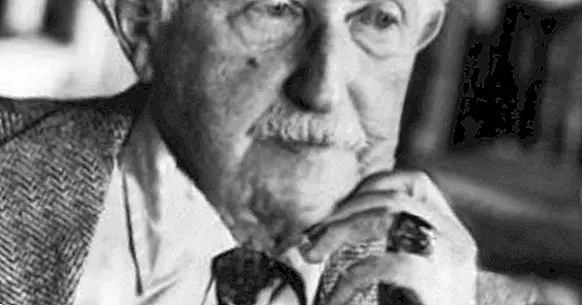The Theory of Psychosocial Development by Erik Erikson
Index
- The Theory of Psychosocial Development by Erikson
- The discrepancy between Erik Erikson and Sigmund Freud
- features of Erikson's Theory
- The 8 psychosocial stages in the theory of psychosocial development
In Evolutionary Psychology, also called Developmental Psychology, the Theory of the Psychosocial Development of Erikson It is one of the most widespread and accepted theories. Next, we will describe some of the foundations of Erik Erikson's theory, as well as describing the stages and their conflicts.
1. The theory of psychosocial development of Erikson
The Theory of Psychosocial Development was devised by Erik Erikson from the reinterpretation of the psychosexual stages developed by Sigmund Freud in which he highlighted the social aspects of each of them in four main facets:
- Emphasized the understanding of 'me' as an intense force, as an organizing capacity of the person, able to reconcile the syntonic and dystonic forces, as well as to solve the crises derived from the genetic, cultural and historical context of each person.
- He highlighted the stages of Freud's psychosexual development , integrating the social dimension and psychosocial development.
- He proposed the concept of personality development from childhood to old age.
- Investigated about the impact of culture, society and history in the development of personality.
2. The discrepancy between Erik Erikson and Sigmund Freud
Erikson disagrees with Freud on the relevance that the latter gave to sexual development to explain the evolutionary development of the individual.
Erikson understands that the individual, as he goes through the different stages, he is developing his consciousness thanks to social interaction .
3. Characteristics of Erikson's theory
Erikson also proposes a theory of competence. Each of the vital stages gives foot to the development of a series of competences .
If in each of the new stages of life the person has achieved the competence corresponding to that vital moment, that person will experience a sense of mastery that Erikson conceptualizes as ego strength . Having acquired competence helps solve the goals that will be presented during the next life stage.
Another of the fundamental features of Erikson's theory is that Each of the stages are determined by a conflict that allows individual development. When the person manages to resolve each of the conflicts, it grows psychologically.
In the resolution of these conflicts the person finds a great potential for growth , but on the other hand we can also find great potential for failure if we can not overcome the conflict of that life stage.
4. The 8 psychosocial stages
We will summarize each of the eight psychosocial stages described by Erik Erikson.
1. Confidence vs. Distrust
This stadium takes place from birth to eighteen months of life , and depends on the relationship or bond that has been created with the mother.
The relationship with the mother will determine the future links that will be established with people throughout their lives. It is the feeling of trust, vulnerability, frustration, satisfaction, security ... that can determine the quality of relationships.
2. Autonomy vs. Shame and doubt
This stadium starts from 18 months to 3 years of the child's life.
During this stage the child undertakes his cognitive and muscular development, when he begins to control and exercise the muscles that are related to the corporal excretions. This learning process can lead to moments of doubt and shame. Also, the achievements in this stage trigger a sense of autonomy and feel like an independent body.
3. Initiative vs Guilt
This stadium travels from 3 to 5 years old .
The child begins to develop very fast, both physically and intellectually. Growing interest in interacting with other children, testing their skills and abilities. Children are curious and positive to motivate them to develop creatively.
In case the parents react negatively to the children's questions or to their initiative, it is likely that they will feel guilty.
4. Laboriousness vs. Inferiority
This stadium occurs between 6-7 years to 12 years .
The children show a genuine interest in the functioning of things and try to carry out many activities on their own, with their own effort and putting their knowledge and skills to use. For that reason, the positive stimulation that the school can offer at home or in the peer group is so important.The latter begins to acquire a transcendental relevance for them.
In the event that this is not well received or his failures motivate comparisons with others, the child may develop a sense of inferiority that will make him feel insecure in front of others.
5. Identity Exploration vs. Identity Dissemination
This stadium takes place during adolescence . At this stage, a question is asked insistently: who am I?
Adolescents begin to show more independence and to distance themselves from their parents. They prefer to spend more time with their friends and begin to think about the future and decide what they want to study, where to work, where to live, etc.
The exploration of your own possibilities occurs at this stage. They begin to shore up their own identity based on their lived experiences. This search will cause you to feel confused about your own identity on multiple occasions.
6. Privacy versus Isolation
This stage comprises from 20 to 40 , approximately.
The way of relating to other people is modified, the individual begins to prioritize more intimate relationships that offer and require a reciprocal commitment, an intimacy that generates a sense of security, of company, of trust.
If this type of intimacy is evaded, one can be bordering on loneliness or isolation, a situation that can end in depression.
7. Generativity against Stagnation
This stadium takes place between 40 to 60 years .
It is a lapse of life in which the person spends his time with his family. The search for a balance between productivity and stagnation is prioritized; a productivity that is linked to the future, to the future of their own and of the next generations, is the search to feel needed by others, to be and to feel useful.
Stagnation is the question that the individual asks himself: What do I do here if it does not work?; He feels stuck and can not channel his effort to offer something to his people or the world.
8. Integrity of the I versus Despair
This stadium occurs from the age of 60 until death .
It is a time when the individual stops being productive, or at least does not produce as much as he was capable of before. A stage in which life and way of life are totally altered, friends and family die, one has to face the duels caused by old age, both in one's own body and in that of others.

Bibliographic references:
- Erikson, Erik. (2000). The completed life cycle. Barcelona: Editions Paidós Ibérica.
- Erikson, Erik. (1972). Society and Adolescence Buenos Aires: Editorial Paidós.
- Erikson, Erik. (1968, 1974). Identity, Youth and Crisis. Buenos Aires: Editorial Paidós.



















